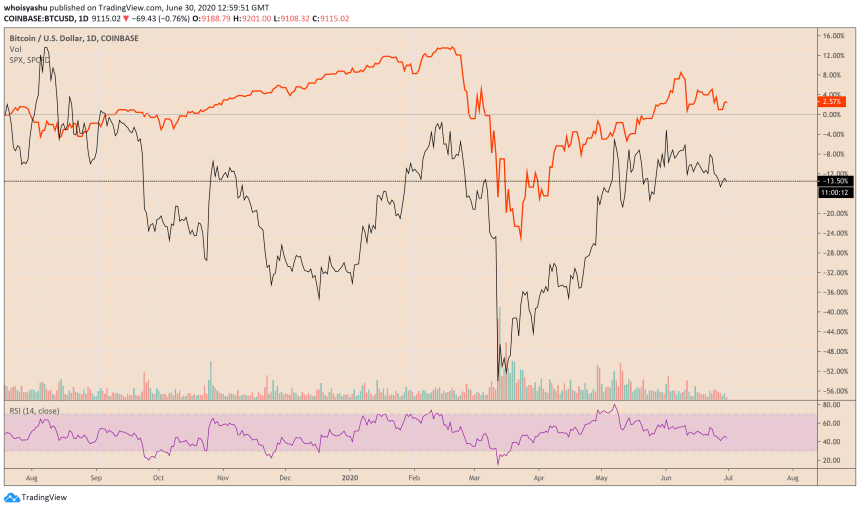Reason to trust

How Our News is Made
Strict editorial policy that focuses on accuracy, relevance, and impartiality
Ad discliamer
Morbi pretium leo et nisl aliquam mollis. Quisque arcu lorem, ultricies quis pellentesque nec, ullamcorper eu odio.
- Bitcoin price risks breaking to the downside as strategists warn of a correction in the U.S. stocks.
- Analysts at JP Morgan & Chase predicted that pensions funds would most likely dump $170 billion worth of their equity positions at the end of the second quarter.
- It would leave Bitcoin under similar bearish spell owing to its growing positive correlation with the S&P 500 index.
Bitcoin may witness sharp downside moves heading into the third quarter of 2020.
The bearish sentiment emerges from the risks of a massive capital shift from the stock market to safer bonds. Analysts at JP Morgan said in a note published last week that they expect pension funds to dump about $175 billion worth of equities as a part of their quarterly portfolio rebalancing strategy.
Scaling Back
Pension Funds aims to maintain a diversified portfolio of stocks, bonds, and other assets. They tend to restructure their holdings at the end of each quarter. Nevertheless, the March 2020 sell-off led both bonds and stocks lower.
The S&P 500, the Dow Jones, and the Nasdaq Composite indices logged an impressive recovery rally from their March 23 nadirs. On the other hand, the Federal Reserve’s decision to cut interest rates to near-zero made sent bonds yields lower, making them an unattractive safe-haven.
JP Morgan analysts estimated that pensions funds increased their exposure in the stock market during its euphoric uptrend between March and June. It is now possible for them to scale back their exposure as the second quarter ends.
Trouble for Bitcoin
The question is whether or not a sell-off in the stock market would hurt Bitcoin. The latest data favors a bearish bias.
Bitcoin since March has moved in tandem with the S&P 500. Moreover, its positive correlation with the U.S. benchmark has grown higher ahead of the second quarter’s close. It indicates that the cryptocurrency would most likely tail the S&P 500, even towards its losses.
Bitcoin price chart showing its correlation with the S&P 500. Source: TradingView.com
As S&P 500 slips owing to quarter-end rebalancing or other reasons, it could lead Bitcoin to retest its support level near $9,000. If the U.S. index extends its breakdown further – especially if investors remain cautious about the resurgence of COVID infections – then bitcoin could, too, extend its fall towards $8,600.
Prominent cryptocurrency analyst Scott Melker believes otherwise. In a statement made on Tuesday, he called Bitcoin an uncorrelated asset. Moreover, he noted that traders should focus more on the cryptocurrency’s negative correlation with the U.S. dollar, instead of the S&P 500.
“Historically, if looking to trade correlation, Bitcoin’s inverse correlation with the dollar ($DXY) is far more compelling than a temporary correlation with SPX,” he explained.
The U.S. dollar index was trading 2.20 percent higher from its June 10 lows.





















